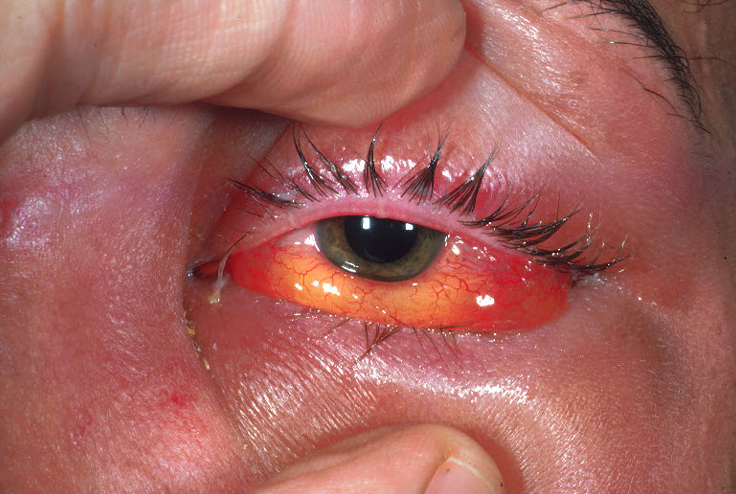
Orbital Cellulitis
Orbital cellulitis is an infection causing inflammation of the orbital contents posterior to the orbital septum. These contents include the periorbital.
Orbital cellulitis is of tissues behind the. It is most commonly caused by an acute spread of infection into the from either the adjacent or through the blood. It may also occur after trauma.
When it affects the rear of the eye, it is known as retro-orbital.Orbital cellulitisOrbital CellulitisIt should not be confused with, which refers to cellulitis anterior to the septum.Without proper treatment, orbital cellulitis may lead to serious consequences, including permanent loss of vision or even death. Gram-positive stain, possibly showing staphylococcus aureus, which is one of the primary causes of orbital cellulitis.Orbital cellulitis occurs commonly from infection spread via the, usually from a previous sinus infection. Other ways in which orbital cellulitis may occur are from blood stream infections or from eyelid skin infections. Upper respiratory infection, trauma to the eye, ocular or periocular infection, and systemic infection all increase one's risk of orbital cellulitis., Haemophilus influenzae B, Moraxella catarrhalis, and are bacteria that can be responsible for orbital cellulitis.
Staphylococcus aureus is a, which is the most common cause of staphylococcal infections. Skate it review. Staphylococcus aureus infection can spread from the skin to the orbit. This organism is able to produce toxins which promotes its, leading to the inflammatory response seen in orbital cellulitis. Staphylococcus infections are identified by a cluster arrangement on. Staphylococcus aureus forms large yellow colonies when cultured (which is distinct from other Staph infections such as, which forms white colonies). Streptococcus pneumoniae is also a gram-positive bacterium responsible for orbital cellulitis due to its ability to infect the sinuses. Streptococcal bacteria can invade surrounding tissues, causing the inflammatory response seen in orbital cellulitis (similar to Staphyloccoccus aureus).
Streptococcal infections are identified on culture by their formation of pairs or chains. Streptococcus pneumoniae produce green (alpha), or partial reduction of red blood cell. DiagnosisEarly diagnosis of orbital cellulitis is urgent, and it involves a complete and thorough physical examination. Common presenting signs include: a protruding eye , eyelid edema (swelling), eye pain, vision loss, inability to move the eye completely , and fever. It is important to correlate physical findings with patient history and reported symptoms.and of the orbits are two imaging modalities that are commonly used to aid in the diagnosis and monitoring of orbital cellulitis, as they can provide detailed images that can show the extent of inflammation along with possible abscess location, size, and involvement of surrounding structures. Ultrasound has also been used as an imaging modality in the past, but it cannot provide the same level of detail as CT or MRI., electrolytes, and a (CBC) with differential showing is a useful laboratory test that may aid in diagnosis.
Differential DiagnosisA variety of pathologies and diseases can present similarly to orbital cellulitis, including:. Inflammatory causes (, ). Infectious causes. Neoplastic, benign and malignant (, ). Trauma (, ).
(congenital, vascular). TreatmentImmediate treatment is very important, and it typically involves intravenous (IV) antibiotics in the hospital and frequent observation (every 4–6 hours). Several lab tests should be ordered, including a complete blood count, differential, and blood culture.
Antibiotic therapy – Since orbital cellulitis is commonly caused by Staphylococcus and Streptococcus species, both penicillins and cephalosporins are typically the best choices for IV antibiotics. However, due to the increasing rise of (methicillin-resistant Staphylococcus aureus) orbital cellulitis can also be treated with,.
If improvement is noted after 48 hours of IV antibiotics, healthcare professionals can then consider switching a patient to oral antibiotics (which must be used for 2–3 weeks). Surgical intervention – An abscess can threaten the vision or neurological status of a patient with orbital cellulitis, therefore sometimes surgical intervention is necessary. Surgery typically requires drainage of the sinuses and if a subperiosteal abscess is present in the medial orbit, drainage can be performed endoscopically.
Yummy mania app. Post-operatively, patients must follow up regularly with their surgeon and remain under close observation. EpidemiologyOrbital cellulitis is an uncommon medical condition, with the reported rates being much higher among the pediatric population compared to the adult population.
One study reported that children are approximately 16 times more likely to suffer from orbital cellulitis compared to adults. It is twice as common among male children compared to female children. Some studies reported that orbital cellulitis follows a seasonal pattern, with the highest rates occurring during the fall and winter, which coincides with the higher rates of sinus infection during the colder months.